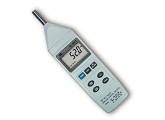November Newsletter 2011 - How to measure sound levels and sound level meters in OHS
| November Newsletter 2011 - How to measure sound levels and sound level meters in OHS The past month has been a busy one for us, with customers wanting equipment to finish projects before the end of the year. Do you have any projects in the pipeline you want to finish? Do you need an instrument to be able to do this? These are the questions you need to start asking to not get caught short before the holidays. As well, we have also had some very organised Christmas shoppers get an early start buying Weather Stations for Christmas presents. Like last year, our Weather Stations look like they are going to be popular options for Husbands, Brothers, Fathers and Grandfathers; we will talk more about our Weather Stations in the December Newsletter. This month we will be taking a look at Sound Level Meters and Loggers, we will look at what it means to measure sound levels and the importance of the calibration of your meter/logger. We are also taking a quick look at measuring the sound levels in a workplace to comply with OSH regulations. Remember; if you have any questions regarding tests you need to conduct or specific instrumentation please give us a call. Until next month...
|
Sound level meters are used for a range of applications including (but not limited to), meeting Government/ Council regulations, monitoring AV outputs and work place safety. We have even had them used in the class room as a teaching device, “now, now children, the sound level meter says you are being too noisy.” Most sound level meters take noise measurements in decibels (dB), which will give you the sound level at that particular instant in time. In some cases, the average sound level over a period of time is required, known as integrated average over time, referred to as LEQ or LEAQ. Because sound level (dB) is a logarithmic scale, to analyse the average sound levels over a period of time you need the meter to integrate the data. As complicated as this all sounds we are able to supply Sound Level Meters and Loggers which automatically perform these calculations, taking the hassle out of it for you. As with any meter, regular calibration is important to ensure the meter is always giving you the best possible results. Sound level calibrators are easy and quick to use, it only takes a minute or two to perform a calibration which can be done on site just before use. Sound level calibrators fit on to the microphone of the sound level meter making a defined sound to compare against. Meters such as the IC1592 come with their own calibrator, whilst individual sound level calibrators such as the C326 or SC-941 can be purchased separately. | |||
There are particular council and government regulations which relate to sound levels in the workplace, how long employees can be exposed to them for. Regulations can differ from council to council, between state governments, and also depending on the industry you work in. It is always best to call your governing bodies to check what regulations apply to your business. “ The national standard for exposure to noise in the occupational environment is an average daily exposure level of 85 decibels. This is consistent with overwhelming scientific evidence which indicates that exposure levels above 85 decibels represent an unacceptable risk to the hearing of those exposed. Many other developed countries have introduced legislation based on this standard. For peak noise, the national standard is a peak sound pressure level of 140 decibels.” Safe Work Australia When keeping track of noise levels in the workplace that are a number of different sound level meters and loggers which you can use. The SL-4012 sound level meter is suited to many different applications throughout the workplace, with the ability to measure between 30dB and 130dB. It is lower cost than some other sound level meters although it is still able to satisfy most general Government regulations The
IC1592 is our only sound level meter supplied with its own calibrator allowing you to take
the most accurate readings possible. It is an accurate and reliable sound level meter which is reasonably
priced, especially considering it is sold with a calibrating unit.
Both the SL-4012 and the C322 units can be calibrated using the same calibrator, the C326 sound level calibrator. The C326 is an easy to use and perfect to use before each measurement to ensure the highest accuracy possible. If you have any questions regard sound level recording please don’t hesitate to call us on 1300737871 and we can talk through your different options. | |||


